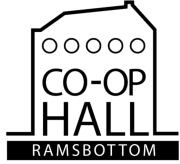Built in 1876 when the Ramsbottom Industrial and Provident Society built a three-storey extension alongside its existing 1863 building on Bolton Street.
The new extension was constructed to house shops on the ground floor with offices, stores and a music hall above.
Seating 800 people, it was the chief theatrical and social venue in the town.
Designed at a point when music halls were steadily moving away from the ‘supper room and promenade’ style with an open concert platform to a more theatrical configuration, the Co-op Hall contained a gallery around three sides with the fourth side containing the stage area with portable proscenium and scenery.
The gallery together with decorative ironwork supporting columns still exists, as do the upper columns and hammer beams carrying the basket-arched roof trusses and original boarded ceiling complete with ornate cast-iron ventilator sunburners.
The Co-op Hall was originally used for variety entertainment of the kind commonly associated with music halls of the period as well as lectures, guild meetings, temperance services and grand concerts.
During the 1920s the hall was used by traveling theatre groups and players. The Co-operative Wholesale Society ran promotional films and smoking concerts in the 1930s.
During World War II it was used as an army training centre and the seating removed, although the balcony level tiering still remains. In 1944 it was taken over by the Labour Exchange and has remained unused since.
Music halls were once numerous everywhere, but only a handful of those of the 1850 to 1880 period now remain. The Co-op Hall, therefore, represents a historically significant building type.
It is also believed important in the history of the Co-op.
Extract taken from Co-op Hall (theatrestrust.org.uk)
